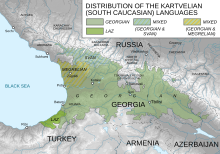Loading AI tools
Ethnic subgroup of the Georgians From Wikipedia, the free encyclopedia
The Svans (Svan: შვანარ, Shvanar; Georgian: სვანი, Svani) are an ethnic subgroup of the Georgians (Kartvelians)[3][4][5][6][7] living mostly in Svaneti, a region in northwest Georgia. They speak the Svan language and are mostly bilingual also in Georgian. Both these languages belong to the Kartvelian (South Caucasian) language family. In the pre-1930 Soviet census, the Svans were categorized as a separate ethnic group (natsionalnost).[8] The self-designation of the Svan is Mushüan, which is probably reflected in the ethnonym Misimian of the Classical authors.[9]
This article needs additional citations for verification. (July 2024) |
 Distribution of the Svan language in relation to other Kartvelian (South Caucasian) languages. | |
| Total population | |
|---|---|
| c. 14,000[1]–80,000[2] | |
| Regions with significant populations | |
| Georgia | 14,000[1]–30,000[2] |
| Languages | |
| Svan, Georgian | |
| Religion | |
| Predominantly † Eastern Orthodox Christianity (Georgian Orthodox Church) | |
| Related ethnic groups | |
| Georgians, Laz and Mingrelians | |

The Svans are usually identified with the Saani mentioned by Greek geographer Strabo, who placed them more or less in the area still occupied by the modern-day Svans.[citation needed]
In the Russian Empire and early Soviet Union Mingrelians and Svans had their own census grouping, but were classified under the broader category of Georgian in the 1930s. They are Georgian Orthodox Christians, and were Christianized in the 4th–6th centuries. However, some remnants of pre-Christian beliefs have been maintained. Saint George (known as Jgëræg to the locals), a patron saint of Georgia, is the most respected saint. The Svans have retained many of their old traditions, including blood revenge, although this tradition has been declining over time and as law enforcement takes hold. Their families are small, and the husband is the head of his family. The Svan strongly respect the older women in families.
Typically bilingual, they use both Georgian and their own, unwritten Svan language. Prior to the 19th century, many Svans were monolingual, only knowing the Svan language.[10]
The most common Y-chromosomal haplogroup among the Svans is G2a (90%), in the second place is the Y-chromosomal haplogroup R1a (5%), in the third place is the Y-chromosomal haplogroup J2a1 (about 3%). Among mitochondrial haplogroups H (17.9%), K (15.8%), W6 (13%), T (9.24%), U1 (7.61%), X2 (6, 52%), U2 (5.98%) are common haplogroups.[11]
Seamless Wikipedia browsing. On steroids.
Every time you click a link to Wikipedia, Wiktionary or Wikiquote in your browser's search results, it will show the modern Wikiwand interface.
Wikiwand extension is a five stars, simple, with minimum permission required to keep your browsing private, safe and transparent.